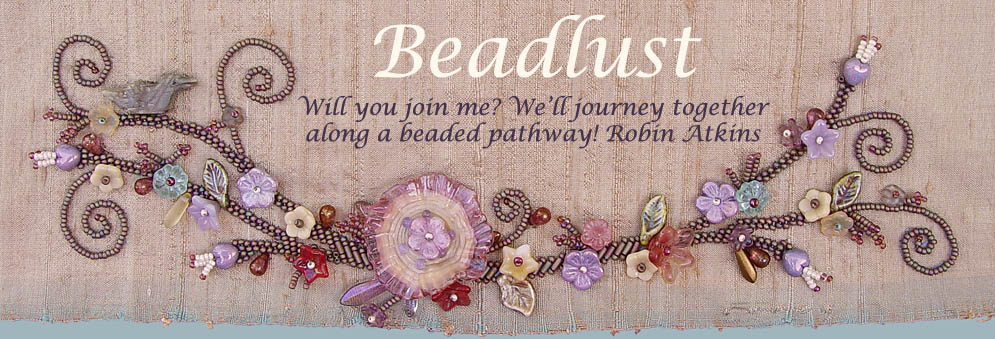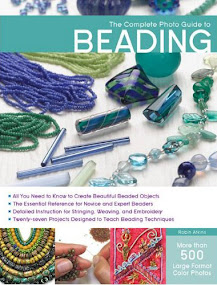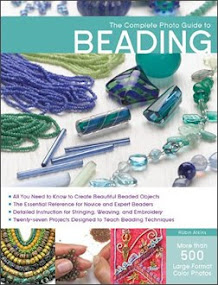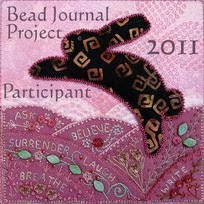Oh dear, I'm sorry to have neglected posting here for so long. Although many suitable topics and photos have passed through my mind and camera, there just hasn't seemed to be a nice chunk of time available for putting it all together. Today is the day to begin again!
 |
| Inspired by Alice, by Marilyn Lidstrom Larson of Willow City, ND (detail of border) |
|
|
For the past two months, it's been all about quilts and quilting for me, with beading taking a bit of a back seat for a while. My quilt and travel buddy, Lunnette, and I flew to Ontario, California for
The Road to California, which is a ginormous quilt show with more than 1,000 quilts on exhibition and over 200 vendors. We gawked (and spent all of our allotted budget) for 3 whole days, barely noticing our fatigue and sore footies.
There are several intriguing subjects to cover, inspired by our experiences there. Today's post is about traditional applique and machine quilting.
 |
Inspired by Alice, by Marilyn Lidstrom Larson of Willow City, ND
photo credit (for this photo only): Road 2 CA |
 |
| Inspired by Alice, by Marilyn Lidstrom Larson, detail showing back |
 |
| Inspired by Alice, by Marilyn Lidstrom Larson, detail of center |
 |
| Inspired by Alice, by Marilyn Lidstrom Larson, detail of center quilting |
Inspired by Alice, shown in the photos above, won the first prize of $1,000 in the
Traditional, Wall, Applique category of the main (judged) exhibit! Take a moment to study the pictures, click on them to enlarge them, notice the way the applique and machine quilting compliment each other. Also think about what this might have looked like if the maker, Marilyn Lidstrom Larson, had hand-quilted her work the way Alice, her grandmother (and inspiration for the central portion of the quilt), would have done. I love this quilt, totally love it, and believe it deserved the award it received.
At the same time, it saddens me that in all the juried/judged shows I've seen (and entered) recently, there is no category specifically for hand sewn quilts... quilts which are hand-pieced, hand-appliqued, hand-embroidered, and/or hand-embellished,
and finished with hand-quilting. Nope, hand-sewn quilts are judged right along with machine-sewn quilts. In my observation, machine-quilted pieces are the ones that win almost all the prizes, even in the
traditional categories. Why is that? Is hand-quilting considered passe, a thing of our grandmothers' time? Is it because machine-quilting has more pizzazz in the viewers' and makers' eyes? Is it because the machine manufacturers are huge financial supporters of these shows and providers of much of the prize money? Is it because the machine manufacturers run the training programs for judges?
OK, let's look into this subject a bit more. Later, I'll tackle the subject of the influence of the machine manufacturers. For now let's consider this question:
Does machine-quilting enhance quilts that are otherwise hand-sewn?
Interestingly, at
Road to California this year, there was a small exhibit of hand-sewn quilt tops, made long ago (most of them in the early 1900s) that were not quilted or layered with back and batting by the maker.
These tops were given to modern machine quilters to finish, and the
results were displayed. Studying them gave me a greater perspective on
the above question.
I
found myself looking at them through the imagined eyes of the original
maker. Would she have been pleased with the finished quilt? As you look
at some of the quilts below (and in a few cases, detail shots), ask
yourself, if you had hand-sewn the top, would you have liked the way it
looks today? Does the machine quilting enhance the work of the original
maker? I've numbered the quilts (in no particular order), so you can
respond (regarding specific quilts) in the comments if you wish. As always, you can click on the photos to enlarge them.
 |
| #1 - Vintage Top with Modern Machine Quilting |
 |
| #1 - Vintage Top with Modern Machine Quilting, detail |
 |
| #2 - Vintage Top with Modern Machine Quilting |
 |
| #3 - Vintage Top with Modern Machine Quilting |
 |
| #3 - Vintage Top with Modern Machine Quilting, detail |
 |
| #3 - Vintage Top with Modern Machine Quilting, detail |
 |
| #4 - Vintage Top with Modern Machine Quilting |
 |
| #5 - Vintage Top with Modern Machine Quilting |
 |
| #5 - Vintage Top with Modern Machine Quilting, detail |
What do you think of these? Which tops are enhanced by the machine quilting? Are there any that don't look right to you? If so, why not?
Since there is quite a difference looking at the photos as opposed to seeing the actual quits, my responses to these questions might be different than yours. To my eyes, #1 offers a believable connection and balance between the quilting and the original applique or piecing. It felt like the original maker would have done something very similar, only by hand.
I didn't want the quilting to overpower the original as it does in #3 and #5. Both of these were so stiff from the dense quilting, that it would be like sleeping under a piece of cardboard. Both of them made me feel disjointed. The lovely charm and grace of the original work seemed lost. I'm not sure why, but the background color created by machine quilting with colored thread in #5 seems almost weird... maybe because it's such an unlikely choice for the period.
Number 4 has the look of a chenille bedspread, both pretty and more-or-less "of the period." It works for me, even though the quilting is dense. The same is true for #2.
More from Road to California coming soon...






























